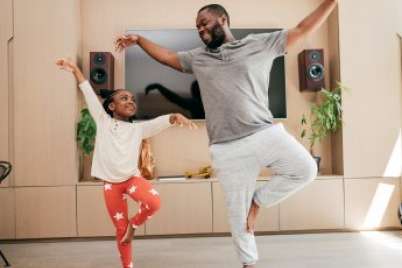
How parent-and-baby aquafit classes inspire physical literacy
I’m far too practical to put much faith in the zodiac. However, there are signs (pardon the pun) that my personality, and that of my 6-year-old daughter, Gillian, are the embodiment of our water signs — Cancer and Pisces respectively. We’re sensitive, artistic and definitely drawn to H2O. I’m a strong swimmer and so is my daughter. Sometimes I joke Gillian could swim before she could walk. After all, her first dip in the pool was when she was only a few weeks old during a trip to a parent and baby aquafit class. Despite running throughout my pregnancy, my postpartum body wasn’t ready for pounding the pavement.
“Water has amazing therapeutic properties,” enthuses Leah Esplen, founder of Mommy Moves Fitness, a company specializing in parent and baby aquafit and yoga classes. Esplen’s inspiration for bringing parents and their babies together in the water was born, naturally, in the pool.
“To be honest, the inspiration behind the mom-and-baby aquafit classes was that I was an aquatic fitness instructor who had just had a baby. I knew that the water was where I needed to be,” says Esplen. “I knew there were other new moms like me who needed a more forgiving workout to progress them into land-based activities.”
Over the years, Esplen has seen the advantages of pool-based exercises for parents and babies and offers insight into how making a splash in the pool could help you, too.
“But my baby doesn’t like the water!”
“I let parents know that their first class is going to be the worst,” says Esplen, adding that she has met parents who are afraid of the water, which babies can pick up on, leading to a fussy baby and a stressed-out parent. “Every class after that first one will get better,” she promises.
It’s important for parents, then, to tend to their babies as they see fit. “For example, some babies fuss a lot if they face Mom the whole time. In that situation, I will recommend they try turning Baby away from them so Baby can see the world,” says Esplen. The change of scenery can cheer your tot up.
If you’re worried that your baby doesn’t like the temperature of the water, Esplen suggests dressing them in a sunsuit or lightweight sleeper, which traps body heat: “The movement of the water across the skin results in convective heat loss and this extra layer tends to minimize it.”
Buoyancy benefits
“Due to the effects of buoyancy, a person feels less gravity in the water. This means that there is less impact on the joints and you can do things in the water that there is no way you could do on land, like jump squats and air-jacks,” says Esplen. She says that when you change your travel direction in water, you use your core muscles to a greater degree than if you were on land.
There is also a two-fold benefit to exercising in the water: hydrostatic pressure (the pressure water puts on your body) forces fluid back into your tissues which decreases swelling, plus more blood goes back to your heart to get pumped out again.
“The buoyancy also helps support different positions and increases the range of motion that you can work through,” adds Esplen.
Physical literacy in the pool—and beyond
It’s not only parents who benefit from the full range of motion available in a water workout.
“When babies are in a land-based class, they either sit or lay against a surface. This means that they can’t actually move in that direction,” says Esplen. She cites the example of how when a baby is lying on their back movement stops wherever there is contact with the ground. On the other hand, when babies are in the water, movement occurs in all planes of motion.
As your baby develops their core strength, you’ll see them able to maintain a vertical position in the water, regardless of the direction you are moving. “You can tell when this starts to happen because their lower body kind of flows in the direction they are moving,” says Esplen.
Core strength and range of motion are the foundation of physical literacy, and as Esplen notes, key to future success in physical activities. In some classes, basic swim skills like blowing bubbles, back floats, and reaching for the wall may be taught.
Skin-to-skin bonding and the fun factor of water fitness
The one-on-one time in the pool means more time to bond with your child. “Because you’re holding onto your baby, rather than putting him/her into a flotation device, there is more interaction between them as well as more skin-to-skin contact,” says Esplen.
Not to mention, pools that offer parent and tot classes tend to be kept at a warmer temperature than recreational pools, making your exercise session more like playtime in a giant bathtub! Look for pools listed as therapeutic, which are kept at balmy temperatures around 80C.
We recently wrapped up Gillian’s spring session of swimming lessons with her passing two levels in only eight weeks. While her success is worth bragging about (which I am, of course!), it was her comfort and confidence in the water that I am most proud of. That’s because long after her swim badges are tucked away in her childhood scrapbook, I know those physical literacy skills she learned from her newborn days together with me in the pool will keep her active for life.





